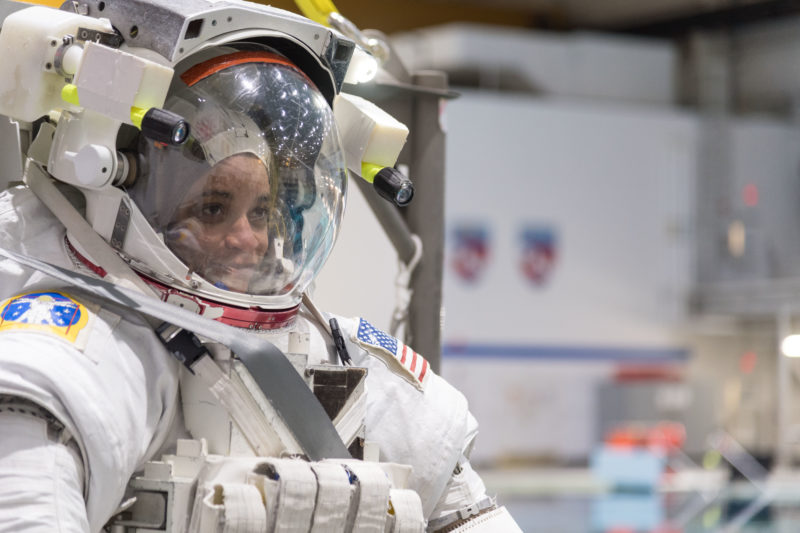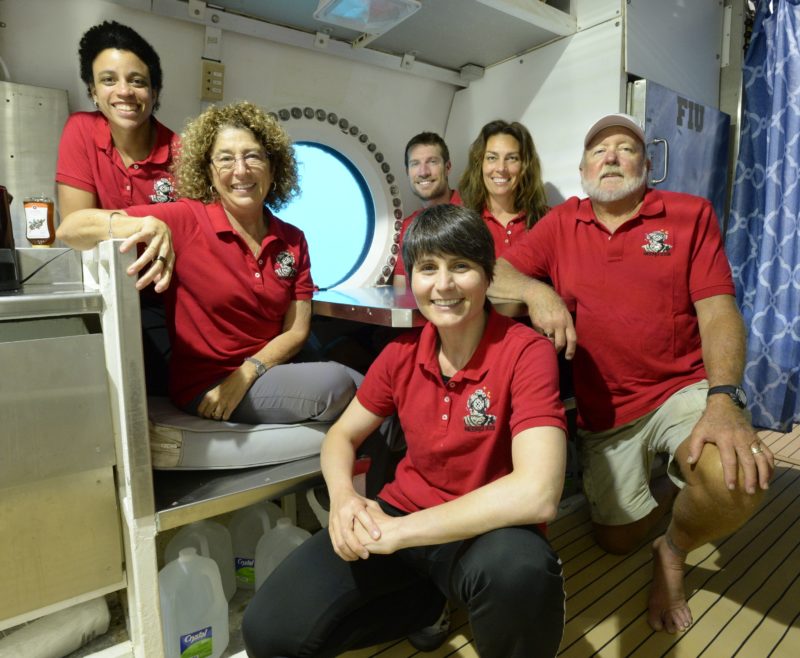
As NASA announced Tuesday that it will roll the first Space Launch System (SLS) super-heavylift booster out to historic Pad 39B at the Kennedy Space Center (KSC) in Florida, for fit-checks later this winter, the agency also assigned “Artemis Team” astronaut Jessica Watkins as a crew member on the next scheduled Crew Dragon rotation mission to the International Space Station (ISS).
Watkins, a geologist and former international rugby player, was selected into NASA’s most recent class of astronauts—“the Turtles”—in June 2017. She will join fellow NASA astronauts Kjell Lindgren and Bob “Farmer” Hines, together with Italy’s Samantha Cristoforetti of the European Space Agency (ESA), when they launch atop a SpaceX Falcon 9 rocket, no sooner than 15 April 2022. In so doing, Watkins will become the first African-American woman to embark on a long-duration ISS increment.
Set to launch a month before her 34th birthday, she will become the youngest U.S. woman to board the space station, eclipsing 34-year-old fellow “Turtle” Kayla Barron, who reached the ISS last week aboard Dragon Endurance.

The news of Watkins’ assignment to Crew-4 was not unexpected, for she has trained alongside Lindgren, Hines and Cristoforetti since August. The quartet were photographed participating in emergency egress and other exercises in the waters of the Neutral Buoyancy Laboratory (NBL) at the Johnson Space Center (JSC) in Houston, Texas.
For their part, Lindgren and Hines were named to command and pilot Crew-4 last February. Lindgren previously spent 141 days aboard the ISS in July-December 2015 and conducted two sessions of Extravehicular Activity (EVA), totaling over 15 hours of spacewalking time.

He later served as backup commander for Demo-2, last summer’s historic flight of Dragon Endeavour which returned U.S. astronauts to space aboard U.S.-built spacecraft, launched atop U.S.-built rockets, and from U.S. soil.
Hines will be making the first spaceflight of his career, having also been selected into NASA’s 2017 Turtles class. And Cristoforetti—who became Italy’s first woman in space in November 2014, then went on to secure a record for the longest single spaceflight ever undertaken by a female astronaut—was named to Crew-4 last May. She spent 199 days aboard the ISS on her first space mission, before returning to Earth in June 2015.

She will rotate into the command of Expedition 68 for part of the six-month increment, becoming only the fourth woman (and the first female astronaut from a European nation) to lead the sprawling multi-national outpost.
It is expected that Lindgren, Hines, Cristoforetti and Watkins will fly a brand-new vehicle to the ISS, as SpaceX brings its fourth Crew Dragon online to join sister ships Endeavour, Resilience and Endurance. However, it remains to be seen what name Lindgren’s crew will select for their vehicle.

Of the ships flown to date, Endeavour is currently the fleet leader, with two long-duration trips to the station and a cumulative 263 days in space. In second place is Resilience, which has also wrapped up two missions, totaling 170 days and including September’s historic all-civilian Inspiration4, which marked the highest-orbiting human spaceflight since the last servicing call to the Hubble Space Telescope (HST).
Resilience also is targeted to become the first Crew Dragon to make a third flight, when she launches no sooner than February 2022 on the commercial Ax-1 mission for Houston-based Axiom Space, with entrepreneurs Larry Connor, Mark Pathy and Eytan Stibbe, commanded by four-time shuttle astronaut and veteran ISS commander Mike Lopez-Alegria.

And in third place on the league table now sits Endurance, which began her first space voyage last week when she lifted Crew-3 astronauts Raja Chari, Tom Marshburn, Kayla Barron and Matthias Maurer to the ISS for a six-month stay.
When Hines and Watkins launch next spring, they will become the third and fourth members of the Turtles class (after Chari and Barron) to reach space. Watkins, who considers Lafayette, Colo., to be her hometown, earned an undergraduate degree in geological and environmental sciences from Stanford University and a PhD in geology from the University of California at Los Angeles.

Her doctoral thesis focused upon the emplacement mechanisms of large landslides on Mars and the Earth. At the time of her selection into NASA’s Astronaut Corps, Watkins collaborated on the science team for the long-serving Curiosity rover.
Following graduation from Astronaut Candidate (ASCAN) training, she was an “aquanaut” on the Aquarius undersea habitat in June 2019, part of the 23rd NASA Extreme Environment Mission Operations (NEEMO-23).

Her commander on that 13-day expedition, deep beneath the waters off Key Largo, Fla., was none other than Samantha Cristoforetti, her future commander on the ISS. And Crew-4’s own commander, Kjell Lindgren, is himself an Aquarius veteran, having commanded NEEMO-22 in June 2017.
Last December, Watkins and Lindgren were among a cadre of 18 NASA astronauts selected into the “Artemis Team” to prepare for America’s steps to return to the Moon in the coming decade. In February, Expedition 64 astronauts Kate Rubins and Victor Glover—both of whom were aboard the ISS when the selections were made—became the first members of the Artemis Team to perform a spacewalk together.

And when Crew-4 arrives at the station next April, the Artemis Team will be represented by no fewer than four of its members: Chari, Barron, Lindgren and Watkins. Perhaps, a few years hence, they may find themselves standing together on the surface of the Moon at its rugged South Pole.
In furtherance of NASA’s plan to return to our nearest celestial neighbor, the maiden Artemis mission draws ever nearer, following this week’s announcement by NASA that it will roll the first SLS/Orion stack from the Vehicle Assembly Building (VAB) to Pad 39B, later this winter, for the Wet Dress Rehearsal (WDR).

This test, which includes loading the behemoth with 700,000 gallons (3.2 million liters) of cryogenic liquid oxygen and hydrogen propellants, will be one of the final milestones before launch.
Completion of these final milestones will clear a significant hurdle ahead of Artemis-1, the three-to-six-week voyage of an uncrewed Orion spacecraft into a Near-Rectilinear Halo Orbit (NRHO) around the Moon and back to Earth. Launch of that mission is targeted for the early part of 2022, with Artemis-2—the first crew-carrying voyage to lunar distance since Apollo 17—anticipated no sooner than 2024.






Jessica Watkins finally poised to steal Jeanette Epp’s glory? Poor Jeannette, she was supposed to be the first black female on ISS back in 2018, but was unceremoniously dumped from the Soyuz MS-09 crew without any public explanation by her employers. To this day no explanation has ever been offered leading to wild conjecture: from racism to her being a rabid social justice activist to not having trained to the required standards of a Russian cosmonaut. Will Jeanette ever fly?
I notice that liberal U.S. news media is hailing Jessica’s first flight assignment to a long-duration ISS mission. With all due respect, it’s no big deal as black women have held prominent positions in the U.S. space program for decades. I just wonder why no African or Caribbean nation ever thought of claiming this “first” years ago by selecting a female candidate then sending her for training in Houston or Moscow? Perhaps it’s not so important unless you make it so.